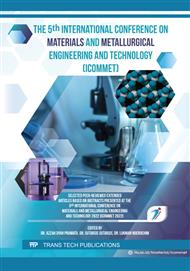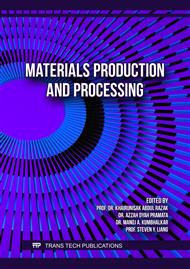[1]
A. Bolt, I. Dincer, and M. Agelin-Chaab, "A Review of Unique Aluminum-Water Based Hydrogen Production Options," Energy and Fuels, vol. 35, no. 2, p.1024–1040, 2021.
DOI: 10.1021/acs.energyfuels.0c03674
Google Scholar
[2]
K. K. Singh, A. Meshram, D. Gautam, and A. Jain, "Hydrogen production using waste aluminium dross: From industrial waste to next-generation fuel," Agron. Res., vol. 17, p.1199–1206, 2019.
Google Scholar
[3]
J. Zhang, F. Pan, R. Zuo, and C. Bai, "The low temperature precipitation in commercial-purity aluminium sheets for foils," J. Mater. Process. Technol., vol. 206, no. 1, p.382–387, 2008.
DOI: 10.1016/j.jmatprotec.2007.12.042
Google Scholar
[4]
D. Kumar and K. Muthukumar, "An overview on activation of aluminium-water reaction for enhanced hydrogen production," J. Alloys Compd., vol. 835, p.155189, 2020.
DOI: 10.1016/j.jallcom.2020.155189
Google Scholar
[5]
A. Bolt, I. Dincer, and M. Agelin-Chaab, "Experimental study of hydrogen production process with aluminum and water," Int. J. Hydrogen Energy, vol. 45, no. 28, p.14232–14244, 2020.
DOI: 10.1016/j.ijhydene.2020.03.160
Google Scholar
[6]
C. B. Porciúncula, N. R. Marcilio, I. C. Tessaro, and M. Gerchmann, "Production of hydrogen in the reaction between aluminum and water in the presence of NaOH and KOH," Brazilian J. Chem. Eng., vol. 29, no. 2, p.337–348, 2012.
DOI: 10.1590/S0104-66322012000200014
Google Scholar
[7]
P. Godart, J. Fischman, K. Seto, and D. Hart, "Hydrogen production from aluminum-water reactions subject to varied pressures and temperatures," Int. J. Hydrogen Energy, vol. 44, no. 23, p.11448–11458, 2019.
DOI: 10.1016/j.ijhydene.2019.03.140
Google Scholar
[8]
H. Z. Wang, D. Y. C. Leung, M. K. H. Leung, and M. Ni, "A review on hydrogen production using aluminum and aluminum alloys," Renew. Sustain. Energy Rev., vol. 13, no. 4, p.845–853, 2009.
DOI: 10.1016/j.rser.2008.02.009
Google Scholar
[9]
L. Soler, J. Macanás, M. Muñoz, and J. Casado, "Aluminum and aluminum alloys as sources of hydrogen for fuel cell applications," J. Power Sources, vol. 169, no. 1, p.144–149, 2007.
DOI: 10.1016/j.jpowsour.2007.01.080
Google Scholar
[10]
L. Soler, A. M. Candela, J. Macanás, M. Muñoz, and J. Casado, "In situ generation of hydrogen from water by aluminum corrosion in solutions of sodium aluminate," J. Power Sources, vol. 192, no. 1, p.21–26, 2009.
DOI: 10.1016/j.jpowsour.2008.11.009
Google Scholar
[11]
A. Irankhah, S. M. Seyed Fattahi, and M. Salem, "Hydrogen generation using activated aluminum/water reaction," Int. J. Hydrogen Energy, vol. 43, no. 33, p.15739–15748, 2018.
DOI: 10.1016/j.ijhydene.2018.07.014
Google Scholar
[12]
X. Wang, G. Li, and R. K. Eckhoff, "Kinetics study of hydration reaction between aluminum powder and water based on an improved multi-stage shrinking core model," Int. J. Hydrogen Energy, vol. 46, no. 67, p.33635–33655, 2021.
DOI: 10.1016/j.ijhydene.2021.07.191
Google Scholar
[13]
A. Ionescu, A. Allouche, J.-P. Aycard, M. Rajzmann, and F. Hutschka, "Study of γ-Alumina Surface Reactivity: Adsorption of Water and Hydrogen Sulfide on Octahedral Aluminum Sites," J. Phys. Chem. B, vol. 106, no. 36, p.9359–9366, Sep. 2002.
DOI: 10.1021/jp020145n
Google Scholar
[14]
S. Prabu and H. W. Wang, "Improved hydrogen generation from Al/water reaction using different synthesized Al(OH)3 catalyst crystalline phases," Int. J. Energy Res., vol. 45, no. 6, p.9518–9529, Jan. 2021.
DOI: 10.1002/er.6478
Google Scholar
[15]
N. K. Park et al., "Purification of Al(OH)3 synthesized by Bayer process for preparation of high purity alumina as sapphire raw material," J. Cryst. Growth, vol. 373, p.88–91, 2013.
DOI: 10.1016/j.jcrysgro.2012.12.004
Google Scholar



